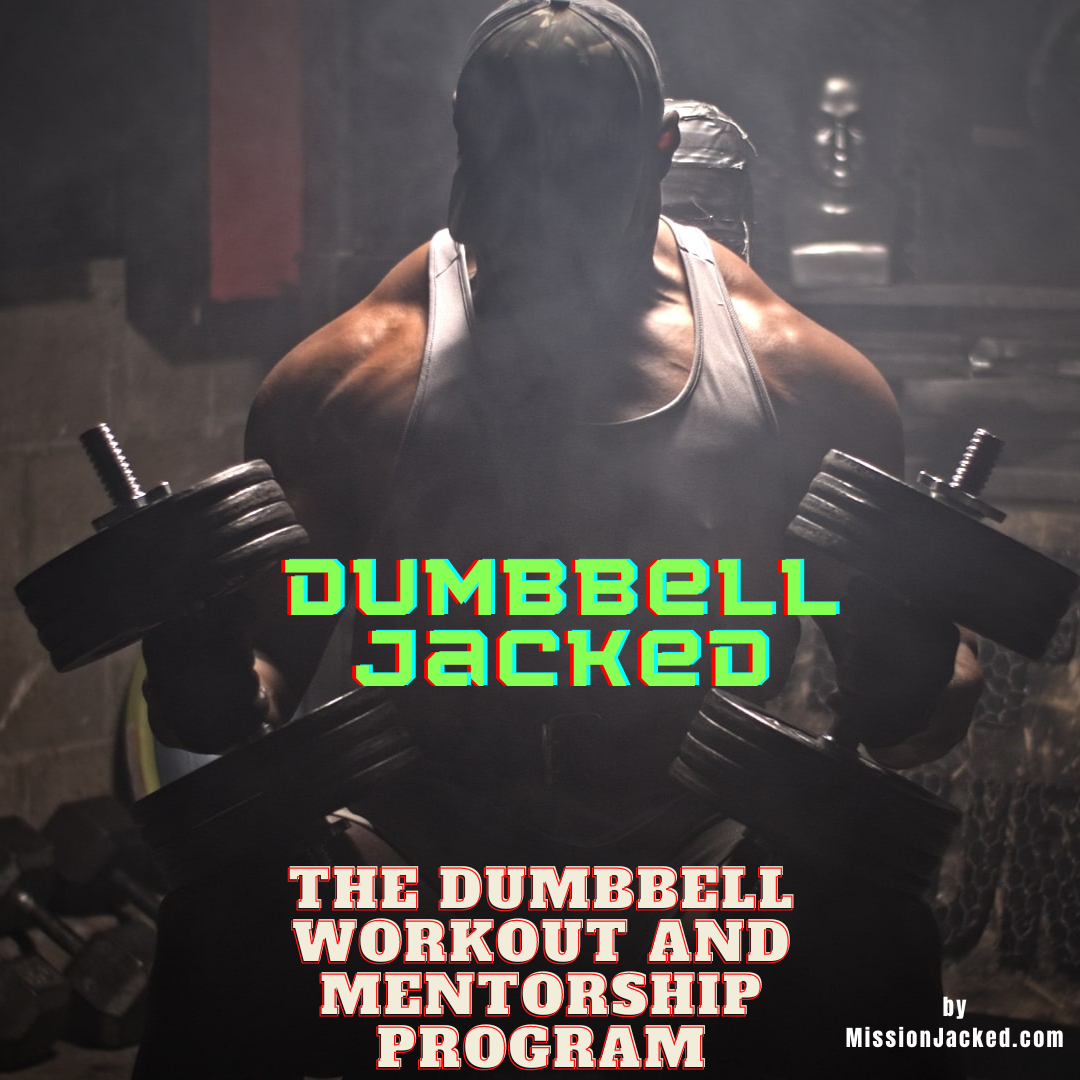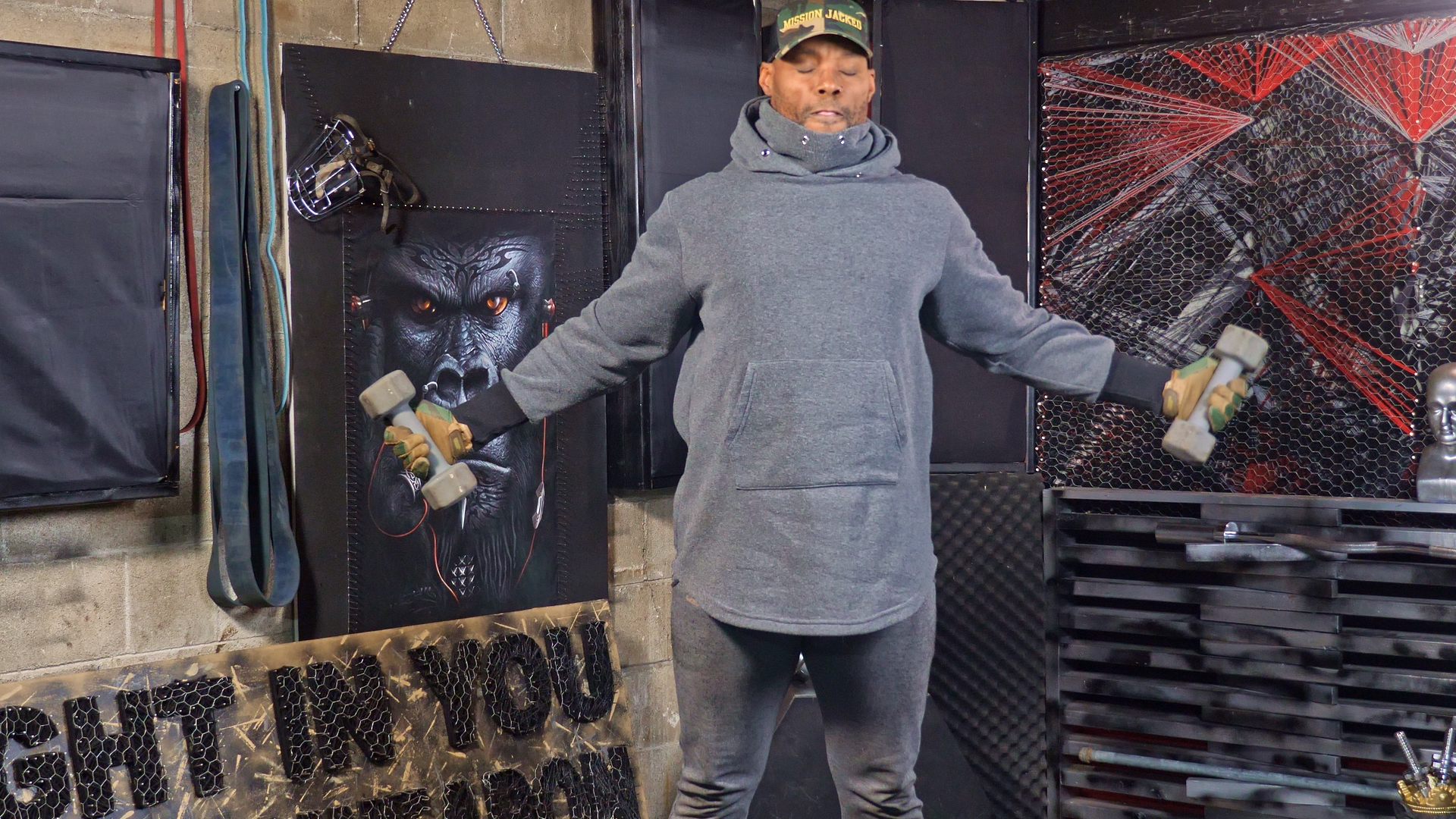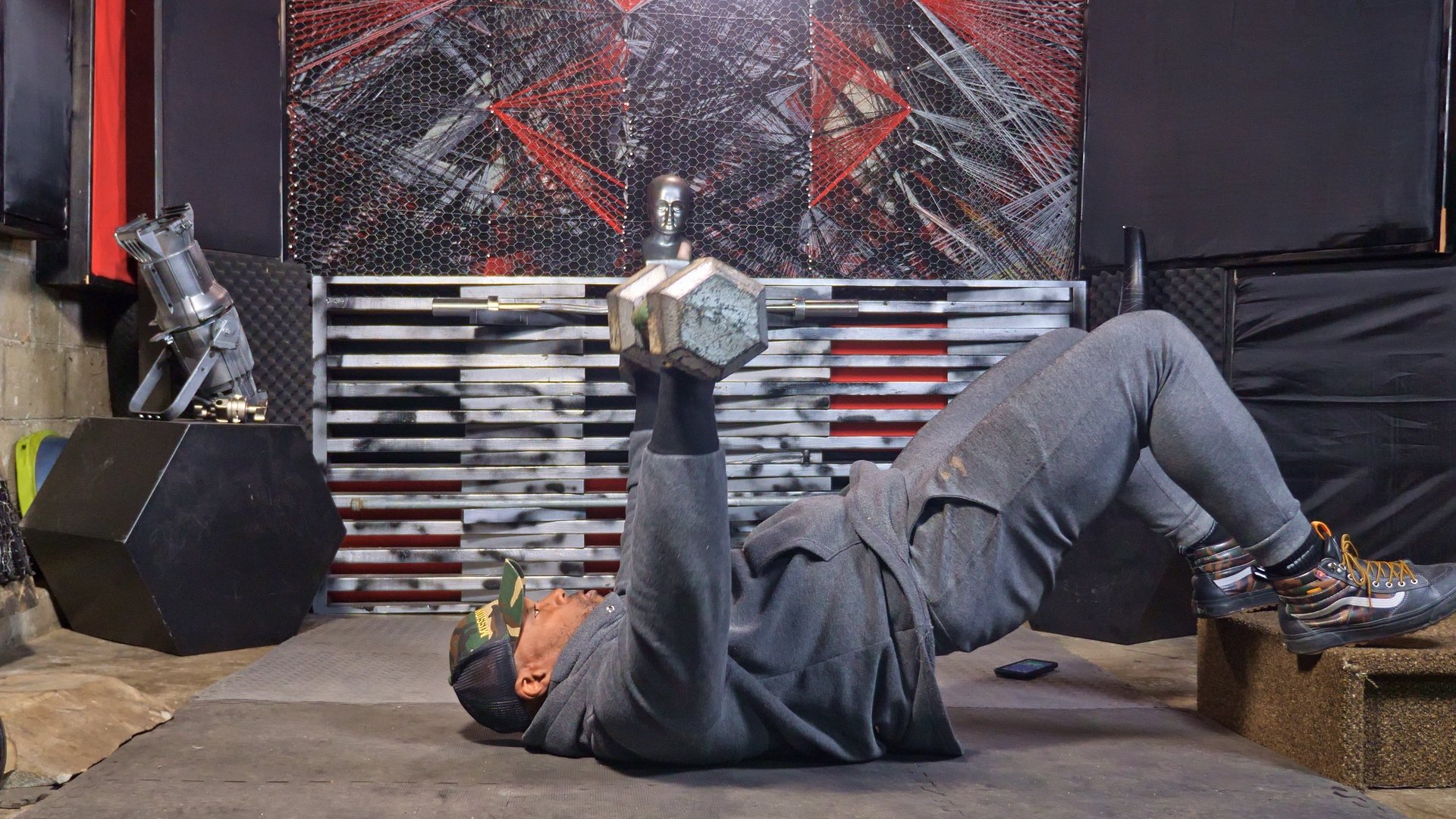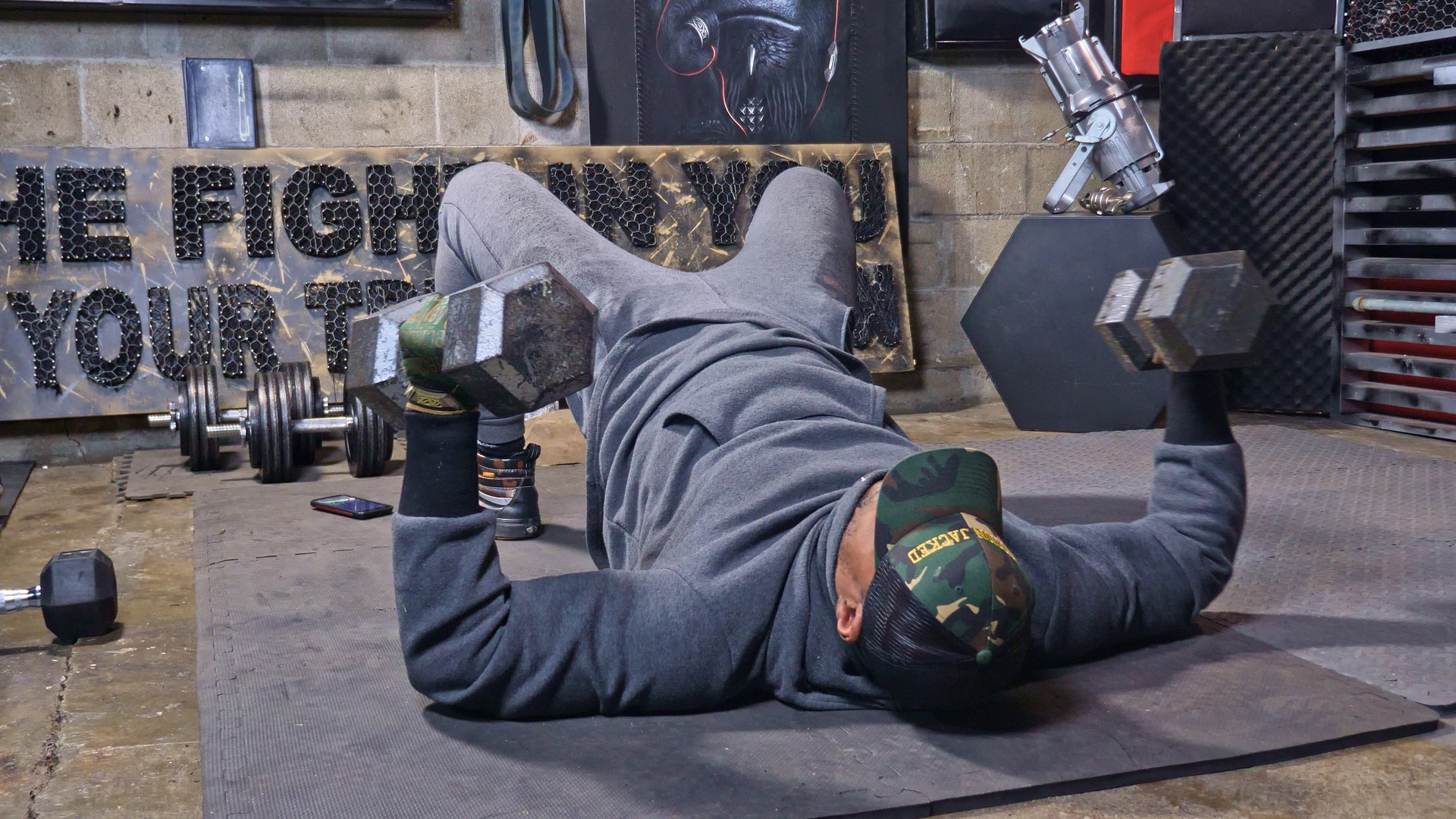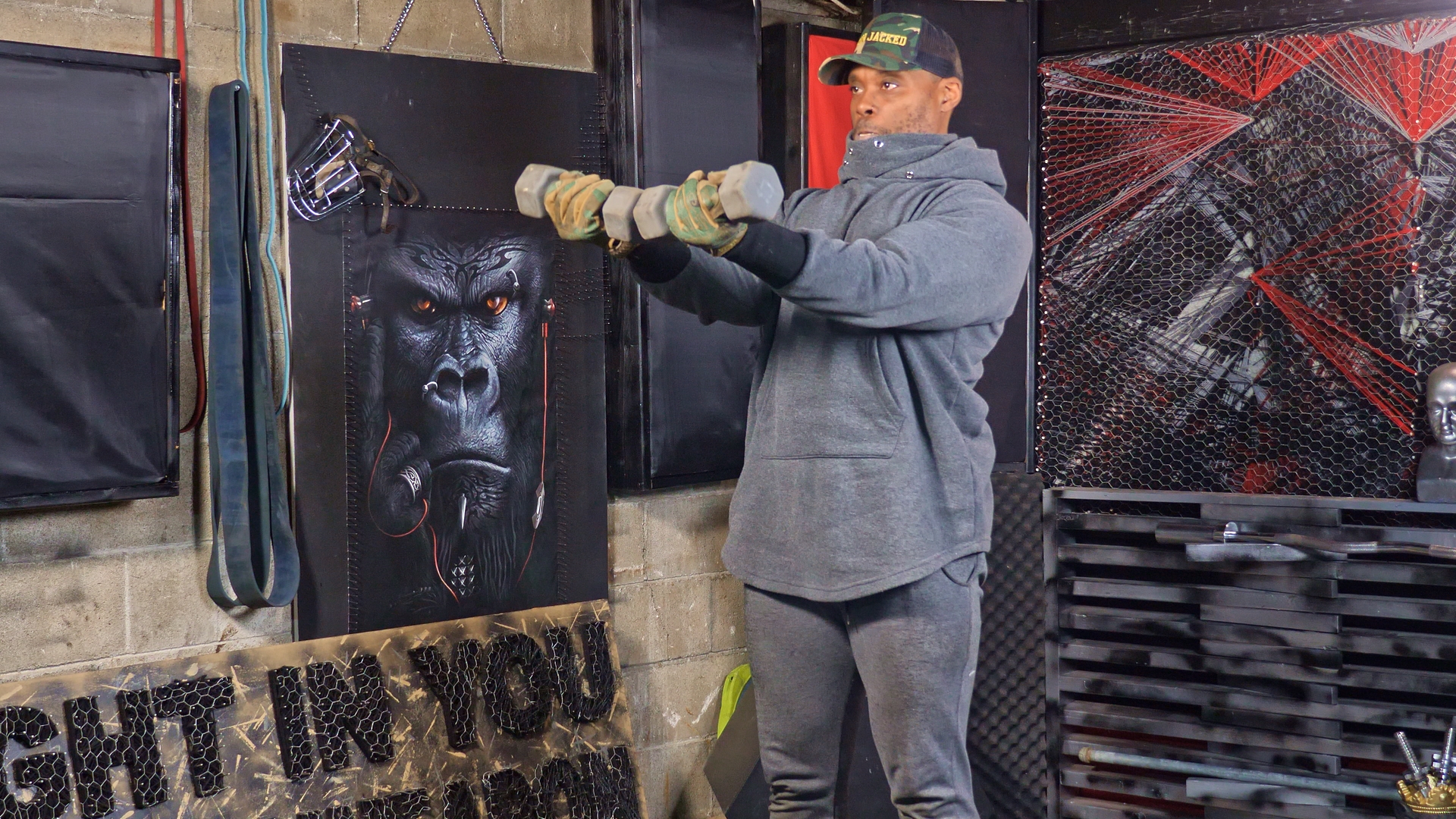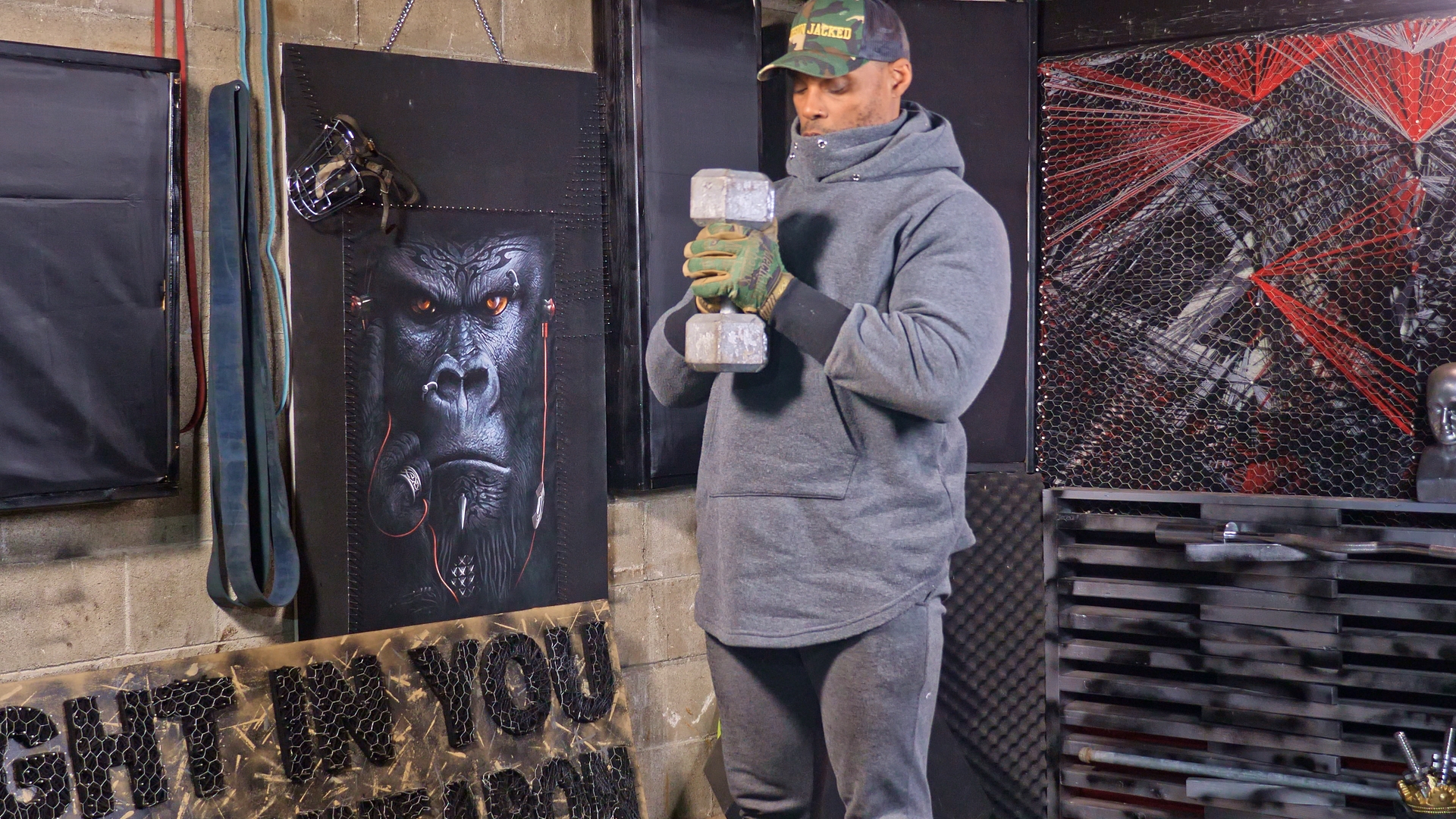Mission Jacked.com
Dumbbell Chest Workout No Bench – No Problem!
Can you do a dumbbell Chest workout no bench and still build muscle? In the Mission Jacked world of developing physiques with minimal equipment, anything is possible.
Table Of Contents
*Introduction *The Flat Barrel Press
*The Standing Fly *Standing Fly Into Press & Squeeze
*The Decline Dumbbell Floor Press *Standing Single Dumbbell Chest Press
*Flat Dumbbell Floor Press *Roller Fly
*The Decline Barrel Press *The Anti-Fly Single Arm Dumbbell Floor Press
Choosing Urethane and Rubber Dumbbells For Your Home Gym
push press benefits
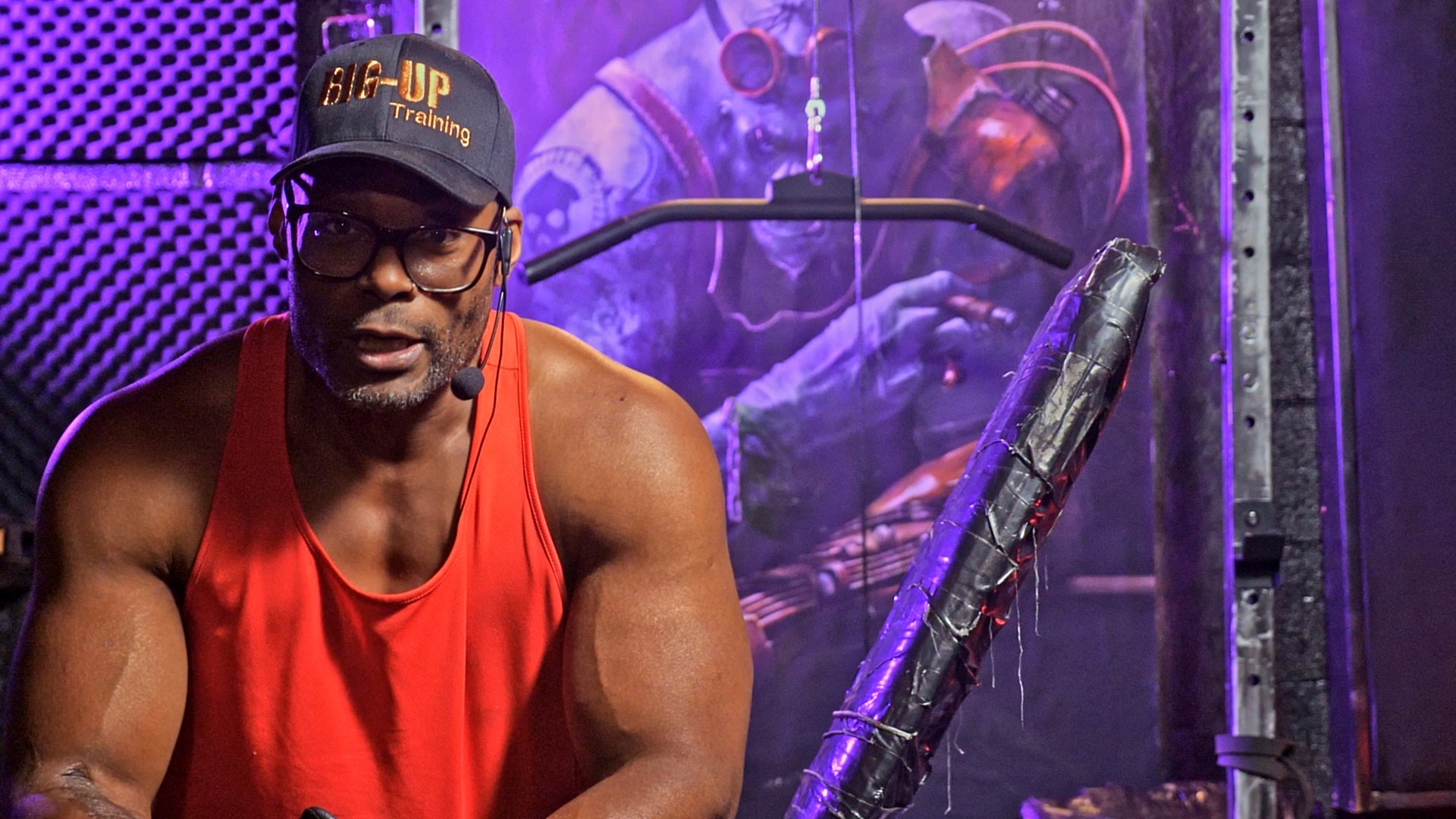
Hi, I’m Psymon H., your online training partner and workout motivator. In my near 40 years of banging iron, I've spent a good portion of that time training at home with less than ideal equipment, and that included the odd dumbbell workout for Chest without a bench.
In this tip-filled article, I’m going to share 3 Chest building tips that you should implement no matter if you’re training using a bench or not. By adding these pointers to your workout, you will put your Pectoral muscles in a much better position to grow.
Next, I’ll uncover 11 awesome dumbbell Chest exercises with cues and pictures so you can be up and running on your next dumbbell Chest workout.
As I’m not a half-measure kind of guy, and because results matter, I’m going to lay out some examples of how to implement the exercises into a workable program. I’ll advise you on sets, reps, training cycles, and to cap this impressive exposé off, we'll turn things up a notch with an intensity technique to put your Chest on notice.
One more important point to make before we kick off this show; if you like what you’ve read, please don’t sit on the information, please share it on your social media platforms by using the “social media share buttons” at the top and bottom of this page; it would be greatly appreciated and will help us to get the word out. Now, grab yourself a drink, and let's bang out a dumbbell Chest workout no bench.
The 3 Most important Dumbbell Chest Workout No Bench Tips:

Regardless of the dumbbell Chest workout, implement these 3 humongous tips to stimulate more muscle growth potential.
Tip One: Let’s start by securing the torso, namely the core area. By keeping your core stable regardless of it being a press or fly exercise, you prevent movement at the spine. If the spine is allowed to move about, it can change the plane and angle of the exercise. If you’re training upper Chest, that’s where you want the stress to go.
The best way to do this is to extend at the Thoracic spine and not at the Lumbar spine by first lifting your Chest before tensing your core and bringing your chin towards your Chest so you are looking down your torso.
Dumbbell Chest Workout No Bench Tip 2:
Learn the origin and insertion of the Chest muscles and how to create distance from the top of your Sternum to the insertion point of your Pectoral muscle. The greater the distance created at the beginning of the movement, the greater the opportunity there is for the Chest muscles to create mechanical tension. So in the case of being at the bottom of a Dumbbell Press, you would start by moving the dumbbells away from the Chest, so they’re set at a right angle to the Chest muscle instead of the dumbbells being tucked almost underneath the Chest. When the dumbbells are tucked in, you are more likely to be using the front Delts and Triceps to a greater degree.
At the top of the movement, you want to concentrate on bringing the origin and insertion points of the Chest muscles together. To do this at the top of a press or fly, you would bring the inside part of your arms (near the armpit) as close to the side of your Chest as possible and then squeeze.
Tip Three: Before starting any movement, lock your Shoulders into place by retracting your Scapula. This will encourage the Chest to do more of the work. In the case of a dumbbell Chest workout no bench, you would pin your Shoulder Blades into the floor and tense through your mid and lower Traps to initiate the first part of the movement. Only when you are near the top of the movement, you would follow through with your Shoulders to finish off the movement.
Arguably the best chest and tricep workout with dumbbells (Part One) if you’re planning on building muscle at home.
Dumbbell Chest
Workout No Bench Exercise 1 -
The Standing Fly:
The hardest part of training Chest without a bench is capturing the upper portion of the Chest muscle. The Standing Fly gives you a great opportunity to target and hunt down the upper portion of the Pecs.
Items Needed: One pair of dumbbells.
Cue 1: Stand with feet Shoulder-width apart with a slight bend in your arms. Have your palms facing forward.
Cue 2: Tense your core, lift Chest high, and retract your Shoulder-blades before bringing the dumbbells up to Chin height.
Cue 3: At the top of the movement, you should have an underhanded grip of the dumbbells. Focus on bringing the origin and insertion points together and at this point squeeze the two nearest knuckles of the dumbbell together as hard as you can before returning to the beginning of the movement.
Cue 4: Be mindful enough to go through cue 2 before each repetition.
Dumbbell Chest
Workout No Bench Exercise 2 –
The Decline Dumbbell Floor Press:
Dumbbell Clean and Press Your Way To A Stronger and Fitter Physique!
For some, building a lower outer Chest isn’t a problem, but for others, this area can be underdeveloped. You don’t need a decline bench to get some lower Chest action; all you need to do is get up in the hip-thrust position, thus changing the angle to a decline position.
Items Needed: A pair of dumbbells and a small platform or crate.
Cue 1: Grab the dumbbells and assume a hip-thrust position on the floor. To get more of a decline, place your feet on the top of a low platform, box, or crate. You should feel yourself resting on the very upper portion of your back. Set your arms so that the dumbbells are set at a 90-degree angle to your Chest muscle.
Cue 2: Retract your Shoulder-Blades by pulling them down and pinning them into the floor. Tense your core and bring your Chin down.
Cue 3: Before pressing the dumbbells, tense your Chest muscles to generate more tension and as you press the dumbbells up, concentrate on bringing your inner arms and outer Chest together and squeeze.
Cue 4: Bring the dumbbells back to the 90-degree start position making sure that the Elbows stay directly under the dumbbells. Think about nailing all of the cues before starting every repetition.
Dumbbell Chest
Workout No Bench Exercise – 3
Flat Dumbbell Floor Press:
This floor press will take care of the entire Chest region, but like with all floor press movements, execution is crucial.
Items Needed: One pair of dumbbells.
Cue 1: Grab the dumbbells and carefully lay back on the floor. Set your arms so that the dumbbells are set at a 90-degree angle to your Chest muscle. Retract your Shoulder-Blades by pulling them down and pinning them to the floor. Tense your core and bring your Chin down.
Cue 2: Before pressing the dumbbells, tense your Chest muscles to generate more tension and as you press the dumbbells up, concentrate on bringing your inner arms and outer Chest together and squeeze.
Cue 3: Bring the dumbbells back to the 90-degree start position making sure that the Elbows stay directly under the dumbbells. Think about nailing all of the cues before starting every repetition.
Choosing The Best Dumbbell Set With Rack 5 50 lb. Combo
Dumbbell Chest
Workout No Bench Exercise 4 –
The Decline Barrel Press
The 3 Best 25 lb Dumbbells On The Market
This is a great alternative to the Decline Dumbbell Floor Press and an exercise that will force you to focus on keeping everything tight and under control. The reason why this is called a Barrel Press is simply that you feel as if you are hugging and pressing a large barrel or beer keg.
Items Needed: A pair of dumbbells and a small platform or crate.
Cue 1: Grab the dumbbells and assume a Hip-thrust position on the floor. To get more of a decline, place your feet on the top of a low platform, box, or crate. You should feel yourself resting on the very upper portion of your Back. Set your arms so that the dumbbells are set at a 90-degree angle to your Chest muscle. Make sure to have your palms facing each other and your elbows directly under the dumbbells.
Cue 2: Retract your Shoulder-Blades by pulling them down and pinning them into the floor. Tense your core and bring your Chin towards your Chest.
Cue 3: Before pressing the dumbbells, tense your Chest muscles to generate more tension and as you press the dumbbells up, concentrate on bringing your inner arms and outer Chest together and squeeze.
Cue 4: Bring the dumbbells back to the 90-degree start position with palms facing in and making sure that the Elbows stay directly under the dumbbells. Think about nailing all of the cues before starting each repetition.
Dumbbell Chest
Workout No Bench Exercise 5 -
The Flat Barrel Press
If you’re tired of rinsing out the same old Flat Dumbbell Floor Press, maybe it’s time to throw in an equally good alternative. The Flat Barrel Press promises to be the equivalent of loading up a truck full of beer kegs.
Items Needed: One pair of dumbbells.
Cue 1: Grab the dumbbells and carefully lay back on the floor. Set your arms so that the dumbbells are set at a 90-degree angle to your Chest muscle. Turn your wrist so your palms are facing each other and your elbows are directly under the dumbbells. Retract your Shoulder-Blades by pulling them down and pinning them to the floor. Tense your core and bring your Chin down.
Cue 2: Before pressing the dumbbells, tense your Chest muscles to generate more tension. At the top of the movement continue to tense your Pecs.
Cue 3: Bring the dumbbells back to the 90-degree start position making sure that the Elbows stay directly under the dumbbells and your palms remain facing each other. Think about nailing all of the cues before starting every repetition.
Want To Get More Jacked?
Join my monthly "More Jacked Newsletter" for even more suggestions and advanced tips on how to get and stay naturally JACKED! When you join, I'll give you a FREE 10 page advanced science-based blueprint on how to take your post-workout nutrition to the next level for even more Jacked Gains to stay ahead of the competition.
Don't Miss Out - Subscribe Today & Get Your Free Gift!
Dumbbell Chest
Workout No Bench Exercise 6 –
The Decline Fly - and
Exercise 7: The Flat Fly
This is an awesome exercise made even better once you forget about everything and concentrate on two areas; creating distance from the origin to the insertion points at the beginning, and bringing the two points as close together at the end of the movement.
Items Needed: One pair of dumbbells and a low platform, crate, or box.
Cue 1: Lie back on the floor and assume a Hip-thrust position so that you are resting on the very top of your upper Back muscles and Shoulder-Blades. Tense your core and bring your Chest up as high as you can go. If you wish to create more of a decline angle, place your feet on top of a low platform or box.
Cue 2: Start with dumbbells overhead and palms facing in. Slowly lower the dumbbells out to the side until your elbows touch the ground. Maintain a slight bend in the arms as not to place unwanted stress on the Elbows.
Cue 3: Before bringing the dumbbells up for the next rep, tense your Chest and torso to generate additional tension on the Pec fibers.
Cue 4: On the way up, focus on bringing the two points together (origin and insertion) and squeeze.
Remove the box for the Flat Fly version and follow the same cues.
Dumbbell Chest
Workout No Bench Exercise 8 –
Standing Fly Into Press & Squeeze
Probably the most torturous standing Chest exercise on the list, but one that will give the upper Chest no choice but to play ball and grow.
Items Needed: One pair of dumbbells.
Cue 1: Stand with feet Shoulder-width apart with a slight bend in your arms. Have your palms facing forward.
Cue 2: Tense your core, lift Chest high, and retract your Shoulder-blades before bringing the dumbbells up to Chin height.
Cue 3: At the top of the movement, you should have an underhanded grip of the dumbbells. Focus on bringing the origin and insertion points together and at this point squeeze the two nearest knuckles of the dumbbell together as hard as you can.
Cue 5: While still squeezing the life out of the dumbbells, lift them and bring them towards you so that they are sitting on your upper Chest.
Cue 6: Reverse all of the cues to get back to the start position.
Dumbbell Chest
Workout No Bench Exercise 9 –
Standing Single Dumbbell Chest Press
If your Chest fibers weren’t paying attention before, they will now. This exercise is an immense addition to any dumbbell workout for Chest without a bench.
Items Needed: One dumbbell.
Cue 1: Stand with feet Shoulder-width apart and grab the dumbbell at Chest-height with both hands so it’s in a knuckle-up position. Retract your Shoulder-Blades by pulling them down. Next, lift your Chest and tighten your core. Have your Elbows set slightly away from each side.
Cue2: While squeezing the handle of the dumbbell in both hands, press out as far as you can go concentrating on bringing the origin and insertion points together.
Cue 3: Maintain the squeeze as you bring the dumbbell back to the start position. Reset cue 1 before starting the next repetition.
Dumbbell Chest
Workout No Bench Exercise 10 –
The Roller Fly
 Roller Fly
Roller FlySay what you want about this unusual exercise, but get the cues right and your Chest will thank you later. The significant difference between doing your fly on a flat bench and performing them on a roller is potentially how much more of the Chest you can activate and how much shoulder stability is needed to fly through the movement.
Items Needed: Medium to long foam Roller and a pair of dumbbells.
Cue 1: Place foam roller on the floor, grab the dumbbells, and lay back on the foam roller, so it starts at the base of your spine and runs up the center of your back.
Cue 2: Start as if you were doing a routine fly with arms straight and dumbbells together. Before lowering the dumbbell, retract your shoulders, and as the dumbbells come down in a fly motion, squeeze your shoulder blades together.
Cue 3: While still squeezing your shoulder blades, lower dumbbells until your elbows touch the ground. On the way back to the top of the movement, practice focusing on your back muscles bringing the dumbbells together.
Cue 4: Make sure to always retract your shoulders at the start of every repetition and squeeze your shoulder blades together all the way down until your elbows touch the floor. Repeat for the desired amount of repetitions.
Dumbbell Chest
Workout No Bench Exercise 11 -
The Anti-Fly Single Arm Dumbbell Floor Press:
This two-for-one exercise should be taken seriously and added to your dumbbell chest workout when you want to give flat dumbbell press a break. I call it a two-for-one movement because while you are actively pressing a dumbbell, you are also trying to battle the tension from a resistance band while attempting to bring the dumbbell to the centerline of your body as if you were completing a fly.
Items Needed: Light to medium resistance band, upright anchor, and one dumbbell.
Cue 1: Attach a light to medium band to the bottom of an upright anchor and place a dumbbell nearby.
Cue 2: Lay across from the band, so it's level with your upper Chest. To pick up both the band and dumbbell safely, roll in towards them and use your non-working arm to help you get them in place. For safety purposes, have the band in the palm of your hand instead of having the band wrapped around the handle of the dumbbell.
Cue 3: Take a palm facing in grip and shuffle out until you feel a little tension in the band.
Cue 4: Start by pressing the dumbbell up while trying to pull the band across the centerline of your Chest.
Cue 5: Slowly lower the dumbbell to the start position and repeat.
Dumbbell Chest Workout No Bench – Training Block
First, let’s talk about training blocks, what are they and why do they matter?
A training block is a succession of training weeks where the main objective is to build muscle. A training block shouldn’t go on forever and must have a start and finish point. Usually, training blocks last for four and sometimes a maximum of five weeks; this gives fatigue time to accumulate over a series of workouts. If you train hard enough and don’t simply go through the motions because you’re doing a dumbbell Chest workout no bench, by week four you will be feeling the effects of fatigue accumulation from being generally weary to your poundage starting to decrease.
At this point, it is always advised that you implement a Deload week where volume and intensity are significantly lower than your normal training sessions. This phase will help maintain any adaptations made over the training cycle while giving your Tendons and Ligaments time to heal.
For this example, we’re going to use three, 4-week training blocks.
Dumbbell Chest Workout No Bench – Full Body Workouts
In this example, we’re going to imagine that you train four times per week. I’m going to use the above exercises spread over 3 training blocks to give you an idea. I’m going to use one Chest exercise and one repetition range per workout session; this will ensure that we work all areas of the Chest through different rep ranges.
For this dumbbell Chest workout no bench sessions, It’s advised you start with a couple of working sets per workout and gradually work your way up to 4 or 5 working sets per session, depending on your ability to recover and training experience. Try and shoot for leaving 1 -2 reps in reserve on all workouts.
Dumbbell Chest Workout No Bench - Tip: If your Chest is considered weak compared to your other muscle groups, make sure to place it at or near the beginning of your workout when energy levels are at their highest. Make sure to fully warm up and warm down to prevent injury and aid recovery.

Dumbbell Chest Workout No Bench - Training Block 1:
Workout 1: The Anti-Fly Single Arm Dumbbell Floor Press x 5 reps per set
Workout 2: Standing Dumbbell Fly x 10 reps per set
Workout 3: Decline Floor Press x 7 reps per set
Workout 4: Standing Single Dumbbell Chest Press x 15-20 reps per set
Dumbbell Chest Workout No Bench - Training Block 2:
Workout 1: Flat Dumbbell Floor Press x 6 reps per set
Workout 2: Standing Fly Into Press & Squeeze x 18 reps per set
Workout 3: Decline Barrel Press x 8 reps per set
Workout 4: Roller Fly x 10 reps per set
Dumbbell Chest Workout No Bench - Training Block 3:
Workout 1: Standing Dumbbell Fly x 15 - 20 reps per set
Workout 2: Flat Barrel Press x 7 reps per set
Workout 3: Decline Fly x 10 reps per set
Workout 4: Flat Fly x 8 reps per set.
(This is also a great place to look if you're searching for ideas for a full-body workout with dumbbells or if you need an inspirational full body workout at home program to get you to "Jacked Beast" Status!)
Dumbbell Chest Workout No Bench – Extras
To add extra tension and focus to different parts of your floor press movements, you could add in a resistance band. As the band offers ascending tension, this will add more resistance to the last third of a pressing movement and help you to get stronger in the push-up phase.
Dumbbell Chest Workout No Bench - Intensity Technique - REST-PAUSE TRAINING
This training method allows you to achieve more repetitions using the same weight and works excellent when lactic acid burn forces you to stop with high reps.
The first thing to do is complete a set to failure and rest for about 5 - 10 breathes before doing a few more repetitions with the same weight. This can be performed 2 – 4 times, dependent on energy levels.
You should choose one exercise per week and use a weight you can do 18 – 20 repetitions to failure and then take five breathes before performing 3 – 5 more reps – rest and repeat – rest and repeat.
I hope you found this dumbbell Chest workout no bench a helpful read. We have more dumbbell Chest workout articles – So get reading – Please share and keep on getting Jacked!
Arguably the best chest and tricep workout with dumbbells (Part One) if you’re planning on building muscle at home.
Top 10 Dumbbell Chest Exercises For 2022
Mission Jacked L.L.C
Address: 9407 NE Vancouver Mall Dr
STE 104 #1269
Vancouver, WA 98662 USA
Email: mission@missionjacked.com

